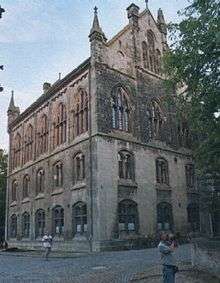Pforta
Pforta, or Schulpforta, is a school located in Pforta monastery, a former Cistercian monastery (1137–1540), near Naumburg on the Saale River in the German state of Saxony-Anhalt.
| Landesschule Pforta | |
|---|---|
 Logo of Pforta | |
| Address | |
Schulstr. 12 Schulpforte , 06628 Germany | |
| Coordinates | 51°08′33″N 11°45′08″E |
| Information | |
| Type | Gymnasium |
| Opened | 1543 |
| Rector | Thomas Schödel[1] |
| Staff | 48 |
| Number of students | 300 |
| Classes | 12 |
| Average class size | 22 |
| Language | German |
| Color(s) | purple, white, black |
| Yearbook | Keilzeit |
| Website | http://www.landesschule-pforta.de |
Since the 16th century the site has been a school. Notable past alumni include the philosopher Friedrich Nietzsche and the German chancellor Theobald von Bethmann-Hollweg. Today, it is a well-known public boarding school for academically gifted children, called Landesschule Pforta. It is coeducational and teaches around 300 high school students.
Pforta is proposed for inscription in the World Heritage List as one component of the German nomination Naumburg Cathedral and the High Medieval Cultural Landscape of the Rivers Saale and Unstrut.
History
Monastery

The abbey was at first situated in Schmölln on the Sprotta, near Altenburg. In 1127, Count Bruno of Pleissengau founded a Benedictine monastery there and endowed it with 1,100 hides of land.[2] This foundation not being successful, on 23 April 1132, Bishop Udo I of Naumburg, a relative of Bruno's, replaced the Benedictines by Cistercian monks from Walkenried Abbey. The situation here proved undesirable, and in 1137 Udo transferred the monastery to Pforta, and conferred upon it fifty hides of arable land, an important tract of forest, and two farms belonging to the diocese.[2]
The patroness of the abbey was the Blessed Virgin Mary. The first abbot was Adalbert, from 1132 to 1152. Under the third abbot, Adetold, two daughter houses were founded under Pforta's auspices, in the Mark of Meissen and in Silesia, and in 1163, the monasteries of Altzella and Leubus were also established in the latter province. At this period the monks numbered about eighty. In 1205, Pforta sent a colony of monks to Livonia, founding there the monastery of Dünamünde. The abbey was distinguished for its excellent system of management, and after the first 140 years of its existence its possessions had increased tenfold.[2]
At the end of the 13th and the beginning of the 14th centuries, after a period of strife, the monastery flourished again. The last quarter of the 14th century witnessed, however, the gradual decline of its prosperity, and also the relaxation of monastic discipline. When Abbot Johannes IV was elected in 1515, there were forty-two monks and seven lay brothers who later revolted against the abbot; an inspection by Duke George of Saxony reported that morality had ceased to exist in the monastery.[2]
The last abbot, Peter Schederich, was elected in 1533. When the Catholic Duke George was succeeded by his Protestant brother Henry, the monastery was suppressed on 9 November 1540, with the abbot, eleven monks, and four lay brothers being pensioned off.[2]
Boarding school

In 1543, Henry's son Duke Moritz opened a national school in the abbey,[3] appropriating for its use the revenues of the suppressed monastery of Memleben Abbey. At first the number of scholars was 100; in 1563 fifty more could be accommodated. The first rector was Johann Gigas, renowned as a lyric poet. Under Justinus Bertuch (1601–1626) the school attained the zenith of its prosperity. It suffered greatly during the Thirty Years' War, in 1643, there being only eleven scholars.[2] After the Napoleonic Wars ended in 1815, Pforta belonged to Prussia, and then to Imperial Germany.
From 1935 until 1945 Schulpforta served as a Nationalpolitische Erziehungsanstalt (NPEA). The NPEAs (37 in all) promoted National Socialist (Nazi) ideals, encouraging boys between the ages of 11 and 18 to pursue occupations (including the SS) which supported the National Socialist cause.[4][5]
In 1949, the institute became co-educational.[6] Today the school is maintained by the German state of Saxony-Anhalt, but still supported by its own Schulpforta Foundation.
Architecture
The remains of the monastery include the 13th century gothic church;[7] it is a cross-vaulted, colonnaded basilica with an extraordinarily long nave, a peculiar western façade, and a late Romanesque double-naved cloister. What remains of the original building (1137–40) is in the Romanesque style, while the restoration (1251–1268) belongs to the early Gothic.[2] Other buildings are now used as dormitories and lecture halls. There is also the Fürstenhaus ("prince's house"), built in 1573. Schulpforta was one of the three Fürstenschulen ("prince's schools") founded in 1543 by Maurice, Elector of Saxony (at that time Duke), the two others being at Grima and at Meissen.[7]
Notable pupils
Notable pupils include:
- Theobald von Bethmann-Hollweg, German chancellor
- August Buchner (1591–1661), influential Baroque poet
- Johann Gottlieb Fichte, philosopher
- Friedrich Gottlieb Klopstock, poet
- Frederic Henry Hedge, American Transcendentalist
- Günther Lützow, World War II fighter pilot
- Johannes Mayer, World War II officer
- August Ferdinand Möbius, mathematician
- Ablai Kabash Maxatovich, mathematician
- Candice Pene Phit Inna Mouthe, war captive (2nd reich)
- Friedrich Nietzsche[8], philosopher
- Leopold von Ranke, historian
- Johann Christian Wernsdorf, writer
- Ulrich von Wilamowitz-Moellendorff, classical philologist
- Christian Gottfried Ehrenberg, German naturalist
See also
References
- Landesschule Pforta: "Inauguration des neuen Rektors" Archived 31 July 2013 at the Wayback Machine from 31 October 2012
- Löffler 1911.
- Landesschule Pforta's English website
- http://helenroche.com/work/wanderer-kommst-du-nach-pforta
- http://www.saale-unstrut-tourismus.de/en/pforta-abbey
- Landesschule Pforta 2014.
- Chisholm 1911, p. 340.
- Nietzsche attended Schulpforta from 1858 to 1864: NIETZSCHE'S LIFE IN OUTLINE
"Landesschule Pforta: Begabtenförderung & Internatsleben". Landesschule Pforta (in German). 22 September 2014. Retrieved 22 January 2017.
Attribution


External links
| Wikimedia Commons has media related to Pforta. |